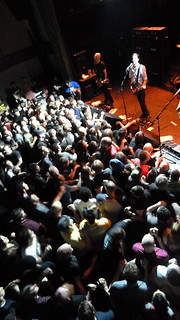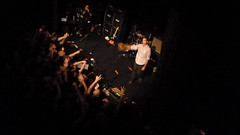Soon after 90s post-hardcore band Quicksand took the stage Friday night for its first hometown show in about 15 years, a half-dozen beers had flown into the air. Bowery Ballroom had never felt so full: virtually the entire audience consisted of men in their 30s and 40s, weighing over 200 pounds.
The mix of metalheads and current and former hardcore guys might have looked like a recipe for the sort of beef that erupted between current and former members of the Cro-Mags at the CBGB Festival last month. But the opening bass notes of “Omission” brought on 90 minutes of rapture. From the balcony to the mosh pit, the entire ballroom pulsed and popped as fans yelled and sang along, arms in the air. They were celebrating the return of a band that broke up in its prime in the late 90s, after touring with acts like Helmet and Rage Against the Machine but never achieving similar breakout success.
After a surprise reunion last month in California, Quicksand had announced two shows: one at Bowery Ballroom and another the next night at Music Hall of Williamsburg. Both sold out in minutes. Rumors of a full reunion came after an appearance on “Late Night With Jimmy Fallon” this week.
Quicksand formed from the fragments of Gorilla Biscuits, Burn and other late 80s New York hardcore groups. In 1990 they released a 4-song EP and then became one of the first bands from the hardcore scene to sign to a major label. Their “Slip” LP came out in 1993, around the time Fugazi released its post-hardcore masterpiece, “In on the Killtaker” and Sunny Day Real Estate’s “Diary” redefined emo music. As those bands perfected post-hardcore’s fury and emotionalism, Quicksand took the sound to a new world of heavy bass, popping drum beats, feedback heavy mid-tempo breakdowns and hip hop-ish choruses that would make Drake quit his day job.
Rage Against the Machine, who also came from the hardcore scene, took the early 90s rap rock sound further. But Quicksand’s unique sound – heavy and melodic, with tinges of shoegaze pop – landed them the headlining spot on the first Warped Tour in 1995.
Anthony Pappalardo an editor at Vice.com who co-authored “Radio Silence: A Selected Visual History of American Hardcore Music,” leads Italian Horn, a new poppy post-hardcore band that opened Quicksand’s New York shows. He said that when Quicksand signed to a label in the early 90s, it became a victim of its own success, since there were few equally successful post-hardcore acts with which to tour. “There was such a disconnect between what people wanted and how to get it to them,” he said. “The brilliant A&R reps put them on tour with White Zombie and Anthrax – that was the landscape.”
Still, the band has had its legacy. Its bassist Sergio Vega is now in the Deftones playing arenas. Mr. Vega hit the downtown scene in the late 80s, playing wild hardcore in bands like Collapse and Absolution before joining Quicksand. He later went on to DJ at East Village and Lower East Side clubs like Lit and Pianos. Before the show Friday he was dressed casually in aqua blue Nike Free sneakers, a matching t-shirt and athletic shorts.
Mr. Vega took the Ballroom’s stage – which he said he had never played before – in the same street clothes, a testament to Quicksand’s no-frills style. Walter Schreifels, the band’s singer-songwriter, was dressed just as casually in a button-down, black jeans and the same Nike Frees as Mr. Vega but in black to subtly match his outfit. A certain New York street style – nothing too fancy but always cool – has always defined Quicksand.
Mr. Pappalardo said the last twenty years haven’t aged the band, in part because its guitarist, Tom Capone, has always been interested in the experimental noise and neo-folk sounds that are fetishized today. “The band has grown sonically and in legend since their absence,” he said. “Instead of ‘playing the hits’ they play the songs in the now, and now is just as good if not better than when I was 15 years old with floppy hair, a beaded necklace and some Girbaud jeans at the Channel in Boston, Mass.”






